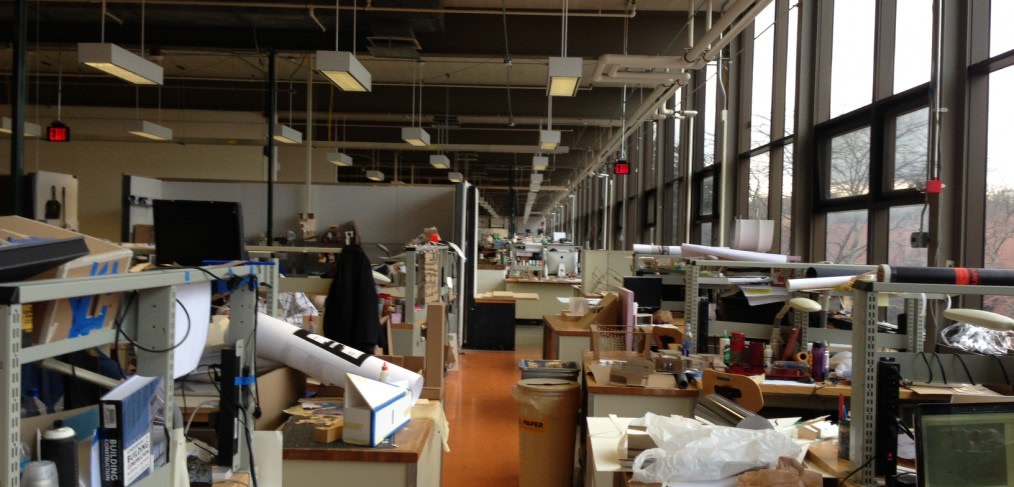
Where the Ideas Live
Perhaps the divide between school and professional practice isn’t as big as we sometimes fear it is.
Nothing like spending a day in a graduate architecture program to make you feel older and wiser. Mostly wiser.
I received an invitation earlier this fall to be on a final jury for “Chicago Urban Laboratory”- an Urban Planning course at the University of Michigan Taubman School of Architecture + Urban Planning, taught by former Chicago architect Suzanne Lanyi Charles. A day away from the office, wandering around the organized chaos of an unfamiliar studio space and critiquing student work sounded good to me, so I accepted.
Upon entering the large open studio space, I felt happy. The familiar sight of cutting boards, chipboard, bass wood, and x-acto knives was immediately recognizable, assuring a doubtful senior citizen that the act of making is still a very big part of an architect’s education at Michigan. However, the same can’t be said for drawing. At least not hand drawing, as in Pentel on trace. In a brief tour of both undergraduate and graduate studios, I saw exactly one student who had pinned up concept sketches. Now, I wasn’t so happy. Laptops were everywhere, and the extremely accomplished digital model progeny of those laptops covered the walls, but I couldn’t help but wonder where the crinkly, smudged, worked-over ideas lived.
After a good hour of prowling, teams of students started setting up their presentations in a wide open residual space between undergraduate and graduate studios. All the teams made use of a “video cart”- a mobile monitor and remote loaded ahead of time with their drawings – as well as some truly Brobdingnagian site models, and a few pinned-up drawings as well. The education backgrounds of the students were unique. In this Urban Planning course, not all had architectural educations and many lacked physical planning backgrounds as well. Some of the team members with non-physical planning concentrations had some truly fierce number-crunching skills and were throwing around acronyms like NOI (Net Operating Income) and IRR (Internal Rate of Return) like nobody’s business. At that point, it became clear that this course was also training some of our future developer clients!
The project site itself was a Chicago brownfield just south of the Loop, in fact a site that I had worked on in 2004, hence my invitation to be on the jury. As team after team of students pitched their ideas, each dutifully recognizing the history, demographics, and physical attributes of this difficult site, I couldn’t help but breathe a sigh of relief that the students’ academic approach, and our own design processes and idiosyncrasies were not so different. Before the jury, I was worried that my years as a professional design consultant hardened by physical, schedule and financial constraints would yield enviable schemes of unrealistic excess. Not so. It was comforting to remember that our own struggles with the site eight years ago were informed by the exact same rigorous, and yes, academic concerns that the students experienced. Their concerns, social and physical, were ours too. I was happy to feel like a student again, in more ways than one.
Back at the office, the familiar sight of study models, laptops, and the papery patina of in-progress design work took on a new look. It looked…like an architecture school studio. And that was all right with me.
What are your thoughts about the state of architecture education?
All Images via Keith Campbell


This is terrific, Keith. Re: the state of architectural education, a handful of years ago, Kira Gould and I did a report for the AIA about how design schools are embracing sustainability in their curricula. Our conclusion, at least at the time, was that generally they aren’t. There are many excellent single courses or elective tracks, but no school has committed to every student becoming steeped in the principles of ecological literacy. Huge opportunity for a school to put a stake in the ground. “Ecological Literacy in Architectural Education.” http://www.aia.org/practicing/groups/kc/AIAS074665
well written and very thougtful, Keith. I particularly like this sentence:
“…the act of making is still a very big part of an architect’s education at Michigan. However, the same can’t be said for drawing. At least not hand drawing, as in Pentel on trace. In a brief tour of both undergraduate and graduate studios, I saw exactly one student who had pinned up concept sketches. Now, I wasn’t so happy. Laptops were everywhere, and the extremely accomplished digital model progeny of those laptops covered the walls, but I couldn’t help but wonder where the crinkly, smudged, worked-over ideas lived.”